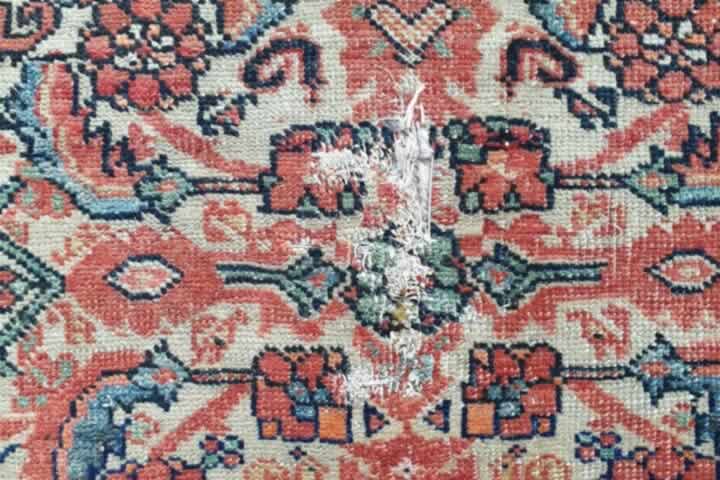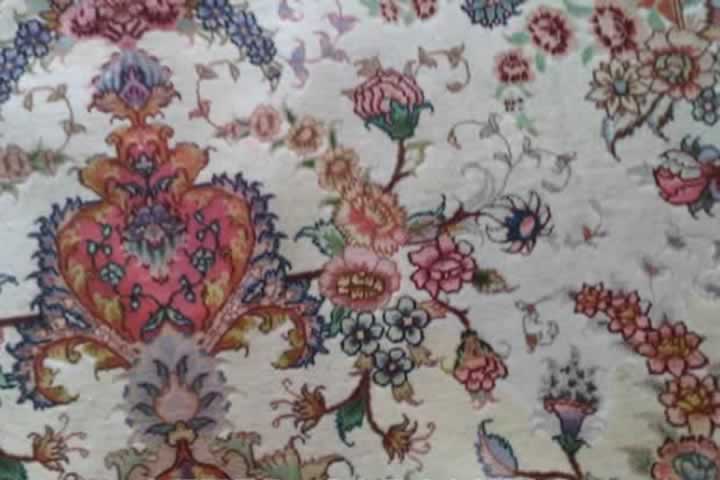Own a Persian rug, but not sure if it’s valuable? Ask our rug experts
The value of a Persian rug can vary greatly depending on many factors. Highly sought after by collectors and enthusiasts alike, understanding the market value of an antique carpet can inform decisions about buying, selling, insuring and restoring these prized rugs. A professional appraisal is essential to evaluate the quality and value of your carpet.
As 3rd generation antique rug dealers and restoration specialists, our team use their expert knowledge and experience to assess the age and origin of your carpet, quality of workmanship, intricacy of the design, knotting and weaving technique, fibres and dyeing method, and overall condition of the rug, to determine its quality, rarity and value.

The Art of Persian Rug Restoration: Bringing Antique Rugs Back to Life
Known for their beautiful designs and rich colours, handwoven oriental and Persian rugs are intricate pieces of art that can add elegance and sophistication to any room. Not only decorative, antique rugs can also hold huge sentimental and historical value, making them an investment that can appreciate in value over time.
To ensure that irreplaceable antique rugs remain functional and beautiful for future generations to enjoy, professional maintenance and timely repairs are essential. Here's what you need to know about caring for your oriental rugs and Persian carpets and the techniques professional antique rug restoration specialists use to restore these beautiful works of art to their former glory.



How professionals clean, repair & restore old oriental & Persian rugs
Rugs and carpets that get walked on are exposed to dust, dirt, spills, stains and pet damage affecting their look & feel. Vacuuming and spot cleaning the odd stain is fine for contemporary wall-to-wall carpets, but valuable Persian rugs require specialist care to avoid them becoming worn or damaged over time, detracting from their beauty and value.
That's why professional cleaning, repair and restoration is the best option to maintain your oriental rug’s beauty and keep it in top condition. Fortunately, with proper restoration techniques, it’s possible to bring the dirtiest and most damaged Persian rug back to life. This is where Rug Nurse’s 3-generations of antique Persian carpet knowledge comes in.
As professionals, we use a range of oriental rug cleaning, repair and restoration methods and techniques, depending on the type, age, rarity, value and condition of the rug, including hand-washing, fringe repairs, patching moth damaged holes, reweaving tears, colour restoration and stain removal, to restore a Persian rug to its former glory.
Specialist rug cleaning is recommended for valuable antique Persian carpets
Experienced Persian rug cleaners and restorers have the right equipment for the job, plus the knowledge to identify the type of rug they are dealing with, where and how it was made (hand-woven or machine-made), the fibres (e.g. wool or silk) and dyes used (e.g. organic or chemical), along with its probable age, condition and value, to determine the most appropriate cleaning method to use.
A professional will also know the safest, most effective shampoos, spot cleaning solutions, colour restorers, deodorisers, insect treatments and protective coatings to use for each type of rug. The more valuable the rug, the more care is needed to avoid causing damage to the rug fibres, colours, and overall stability of the rug during cleaning.
Cleaning methods may include dry-cleaning, power-washing or hand-washing for valuable and fragile rugs. A professional cleaner may also use specialised equipment designed to clean rugs gently yet thoroughly, such as powerful vacuum cleaners, dusting machines that vibrate the rug to remove dust & dirt particles from the pile, commercial power washing and drying systems to ensure your rug is perfectly clean and dry (not damp) before it is returned to you.
Hand-washing is preferred for cleaning valuable rugs, as it allows for thorough cleaning without damaging the fibres. The process involves soaking the rug in water and carefully washing it by hand using gentle detergents and soft brushes. Several shampoo applications and rinses may be required for a very dirty rug. More robust rugs may benefit from power-washing with a hand-operated machine or submersion in special rug washing-machine.
Your rug may then be spun in a centrifuge to remove excess water, before either mechanical drying or being hung to continue air drying. Done properly, both hand-washing and power-washing techniques can help remove dirt, stains, and odours while preserving the rug's vibrant colours and intricate details.
Why rug cleaning precedes rug repair
It is recommended that a Persian rug be cleaned before it’s repaired, because a clean rug will show any damage or wear more clearly, making it easier for the repair technician to identify and address the issues. Also, if a rug is repaired before cleaning, dirt and other contaminants in the rug may be sealed in, making it harder to remove them during the washing process.
The difference between rug repair & rug restoration
The difference is in the scope and extent of work involved.
'Persian rug repair' generally refers to fixing a specific issue, such as repairing a tear or a hole, fixing a frayed edge, or reweaving a damaged section. The focus is on making the rug functional again.
'Persian rug restoration' on the other hand goes beyond repairing a specific issue and typically involves a more extensive process that may include cleaning, repairing & reweaving multiple areas of damage, plus color correction to match the original design and bring the rug back to as close to its original condition as possible.
Specialist antique rug repair & restoration techniques
Because many antique rugs are fragile and often valuable, rug restoration is a highly specialised and intricate process. It requires an in-depth knowledge of the original rug-weaving process and fibres used, to restore an old rug to its original condition, or as close to it as possible. Click to expand each section below to read more about each of the various techniques involved, such as patching holes, repairing tears, rebuilding and reweaving worn areas, colour restoration and re-dyeing faded colours.
Foundation repair refers to repairing the warp and weft threads— the vertical and horizontal threads that form the foundation of a rug, on which the surface pile is woven. This may involve reweaving or reinforcing damaged warp and weft threads, weakened over time due to wear and tear or exposure to the elements. A proper foundation repair is important for stabilising and maintaining the structural integrity of a rug and preventing further damage or deterioration. Skilled rug repair technicians perform repairs using techniques such as hand-knotting, stitching, or patching to reinforce a weakened area.
Oriental Rug Patching is a common restoration technique used to repair holes or tears in Persian rugs. This involves removing damaged fibres and replacing them with new ones that match the colour and texture of the surrounding area. Our expert technicians use a variety of tools and techniques to ensure that the patch is seamless and blends in perfectly with the rest of the rug.
If your Persian rug has more extensive damage, such as large tears or holes, reweaving may be necessary. This involves carefully reconstructing the damaged area by replacing missing or damaged threads with new ones, weaving or knotting the new fibres into the existing rug. Our skilled technicians use traditional weaving techniques to ensure that the repair is both sturdy and aesthetically pleasing.
Antique carpets can fade and lose their colour vibrancy over time due to exposure to sunlight, dust, and other factors. Persian rug and carpet colour restoration involves using specialised techniques to carefully restore the rug’s original colours, shades and patterns. This may include colour-matching and dyeing faded, discoloured and stained areas to match the rug’s original rug colours, to ensure that the restored area blends seamlessly with the rest of the rug.
Dye-bleeding occurs when the dyes in a rug bleed into each other, possibly from poorly executed DIY spot cleaning, causing discoloration in surrounding areas of the rug. Specialised colour correction techniques can help minimise dye-bleeding and revive the beauty and value of an antique carpet, making it a treasured piece for generations to come.
One of the most significant threats to handmade rugs is moth damage. Moths can cause extensive damage to the fibres of the rug, which can weaken the structure, resulting in holes and cause it to unravel. Oriental rug moth damage repair involves first carefully examining the rug for signs of damage, including holes, frayed edges, and weakened fibres. The repair process then may involve reweaving damaged areas, reinforcing weakened fibres, and finally treating the rug by applying a protective coating to prevent future moth infestations and damage.
.
Pets can leave behind stains and odours on Persian rugs, which can be difficult to remove without damaging the delicate fibres. Persian rug pet stain removal involves identifying the type of stain and using specialised cleaning agents and techniques to remove it without causing further damage. This may include spot cleaning, steam cleaning, or hand-washing, depending on the severity and extent of the stain.
The fringes and decorative tassels on an oriental carpet are an integral part of the rug’s design. They are also prone to damage from wear and tear. Fringe repair involves reattaching loose fringes, reinforcing weakened areas, and complete or partial re-fringing to replace damaged or missing sections of the rug fringe. Discoloured or stained fringe sections also detract from the appearance of an otherwise beautiful rug. Colour correcting sections of a heavily discoloured fringe back to its original colour, combined with fringe repairs and re-fringing can help restore the beauty and functionality of an oriental rug while preserving its authenticity and value.
Selvedges are the finish along the long side edges of a rug that secure the weft threads of a rug. Finished either with a binding, overcasting or whipstitch when the rug is made, the selvedge can become damaged and require repair to stop the fabric of the rug fraying. Whichever method was used when the rug was originally woven is normally used to repair a selvedge, depending on the extent of the damage, A badly frayed selvedge may require patching or reweaving of a section of the rug before the selvedge can be repaired.
Water damage can cause severe damage to a Persian rug, including mould and mildew growth, discoloration, and weakening of the fibres. Persian carpet water damage restoration involves identifying the extent of the damage and taking appropriate measures to restore the rug’s integrity. This may include drying the rug thoroughly, removing mould and mildew, and repairing or replacing damaged fibres.
Very old antique rugs are often delicate and prone to tearing from regular use or accidents. Antique rug tear repair involves identifying the extent of the tear and using specialised techniques to repair it without causing further damage. This may include reweaving damaged areas, reinforcing weakened areas, or adding new fibres to fill in the tear. Proper tear repair can preserve the integrity of an antique rug and help maintain its value and beauty for years to come. A skilled restorer can carefully repair tears in a way that is virtually undetectable, making the rug look as good as new while preserving its historical and cultural significance.
Our own expert craftsmen clean and insect-treat all rugs in our climate-controlled premises before we begin repairs
Treatment timescales
As with any bespoke work, it can be hard to estimate treatment or repair times, but once we have sight of the rug, we may be able to give an estimate which is dependant on availability of materials.
Guarantees
We offer a full money back guarantee if you are not totally satisfied. Our business is fully insured, giving you the assurance you need when leaving your valuable property with us.
Collection & delivery
We provide a free pick-up and delivery service in Oxfordshire and the Cotswolds. Contact us for rates in surrounding areas.

















